TEA AND COFFEE CULTURE
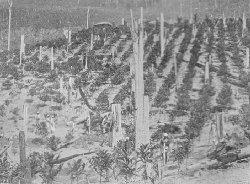 | | Coffee plantation. |
England is a nation of tea drinkers, with little favor given to coffee. In fact tourists claim that it is the next thing to impossible to get a good cup of coffee in Great Britain. From the English comes the retort that the same condition regarding tea prevails in America. One thing is certain, Americans know how to brew excellent coffee, and hence that beverage has become very popular with the people of the new world.
FRANCE PREFERS COFFEE.
France offers coffee as its favorite beverage, with tea and chocolate in the order named. The French also practice adulteration, with the result that in many of the big restaurants where coffee is served the taste of that article cannot be detected.
TEA THE FAVORITE OF RUSSIA.
The Russians are the greatest of all tea drinkers, obtaining their supply chiefly by caravans, into Siberia, from the Chinese provinces, where the best crop is produced. The Russian samovar, or tea-urn, is perpetually alight in every household of the empire, and tea is served not only at every meal, but to every caller between meals, and on all sorts of surprising occasions. Even a business call at a bank or office is almost certain to bring the offer of a glass of scalding tea, to be taken while the errand is explained.
Coffee culture extends over almost the whole of the tropical belt of the globe. The plant seems to bear greater climatic extremes than most members of the vegetable kingdom, and thrives in localities differing as much as thirty degrees in average temperature.
THE COFFEE TREE IN BRAZIL AND JAVA.
In Brazil, there are 16 varieties of coffee growing wild. The limit of productiveness is about 30 years. After that time, the trees may live and continue to grow, but they yield little or no fruit. In Java, coffee trees, planted nearly a hundred years ago, are said to be in existence, being now about 40 feet high, with trunks a foot in diameter; but they grow entirely wild and produce no berries. On an average, trees are replaced on the plantations every 20 years, and this process of replanting goes on constantly.
HOW COFFEE IS GROWN.
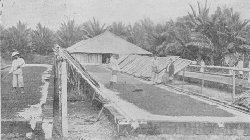 | | Drying the coffee. |
Coffee grows best on the uplands, usually on the mountain side at an elevation of from fifteen hundred to forty-five hundred feet above the level of the sea. The trees are raised from the seeds in nurseries, and transplanted when about a year or eighteen months old. The plants are usually set at intervals of eight or ten feet. They begin to bear at the age of three or four years, and when six years old, may be said to be in full bearing. Taking one year with another, a tree in full bearing produces from two to three pounds per annum. The average diameter of the trunk in full bearing trees is about the size of a man's wrist. They bear a profusion of dark-green, glossy leaves, and the fruit or berry forms on the woody stems, usually at the base of these leaves.
The berry, when ripe, is red in color, and much resembles a large cranberry. The two beans lie within, face to face, and surrounding them are five successive layers of skin and pulp, which cover and protect the beans.
COFFEE PICKING.
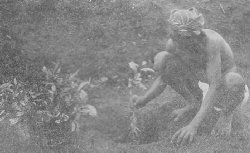 | Translplanting tea.
The plant is brought from the nursery. |
Picking begins, in Java, in January, and lasts for three or four months. The chief part of the Ceylon crop is gathered from April to July. A small crop, chiefly of young coffee, is picked from September to December. In Brazil, they commence gathering crops in April or May, and work continuously until September. Women and children are largely employed in gathering the fruit, carrying it from the trees in baskets to the place where the preparation of the berries for market commences.
PULPING AND DRYING.
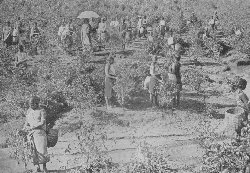 | Tea plucking in Ceylon.
The man with the umbrella owns the coolies. |
After the berries have been gathered, the first operation to which they are treated is called "pulping." This means to remove the outer covering of skin and pulp from the beans themselves. The berries may be treated while in the soft state, or they may be permitted to dry, after which the dried husk is removed by a machine. When this process is chosen, the berries are spread upon the drying grounds of stone, mortar or cement, where they stay until the heat of the sun prepares them for the machine. It is a similar machine, differing only in details to that which is used when the berries are to be treated in the soft state. Successive cleanings, washings and dryings finally bring the coffee into a condition for shipment to the markets, thousands of miles from the plantation where it is raised.
PRINCIPAL TEA PRODUCING COUNTRIES.
Tea in the Western Hemisphere does not figure very largely in a commercial sense, although in our own Southern states certain experiments have been made which suggests that good tea could be cultivated, even though it might not be highly profitable.
TEA CULTIVATION.
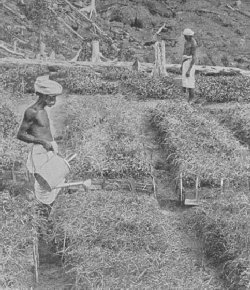 | | Tea nursery shaded by ferns. |
Japan, China, the Island of Formosa, India, and Ceylon are the principal tea producing countries. The tea plant is a speciesof camellia, bearing a thick and glossy leaf, which, when green, has no tea flavor, or rather has a flavor very unlike the cured leaf known to us as tea. There is considerable variety in the mode of cultivating, but the prevailing system is to plant in rows about six feet apart. Three or four plants are placed together in hills, which are about three feet apart, and usually as they grow larger they fill nearly the whole original space left between the hills, thus making an almost continuous row. The plants are raised from the seed, and take from three to four years to mature sufficiently to yield the first crops. After that they are picked continuously for many years.
TEA PICKING.
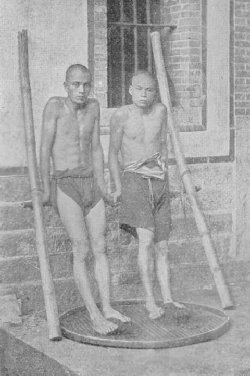 | | How tea is powdered by the feet. |
In the districts yielding the best variety of tea, the plants are covered, during the winter and early spring, with mats, which serve the double purpose of protecting them first from cold which might injure them, and, later, from the sun which tends to make the leaf tough and injures the delicacy of the flavor. The first picking, which is considered the best, takes place, in Japan, during the last of April or the beginning of May; the second, a month later; while the third, which is often omitted, usually takes place during July. Left to themselves, the plants would probably grow to a considerable height, but they are trimmed and pruned down so that they are seldom more than three or four feet high. This results in a number of small branches, producing small and tender leaves, which are the only ones sought for, although in rapid picking different sized leaves would naturally be taken, together with a considerable quantity of stems and other trash.
THE CURING AND FIRING PROCESS.
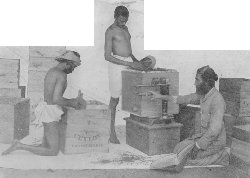 | | Weighing tea chests—85 pounds each. |
From the field, the leaves are taken to buildings for the curing processes. The flat baskets in which the tea is brought from the fields are placed over the steaming apparatus for a few seconds, the steam permeating the mass and wilting the leaves. This gives them the dark-green color, and enables the leaf to be rolled and doubled up, so that there is less liability to crumble when fired. They are then thrown upon large paper pans beneath which a gentle coal fire is maintained. They are roasted here for several hours, during which they are constantly rolled and stirred with the hands, so as to make the leaf as compact as possible. The tea is then placed in large baskets to await the sorting process.
SORTING.
The leaves are afterwards spread out before the sorters, who with a pair of chop sticks, dexterously pick out the stems and coarse leaves, which are thrown aside as refuse. Then the rest is sifted and packed to be sent to the market.
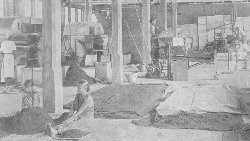 | Inside a factory roller—fermentation
to get rid of useless elements. |
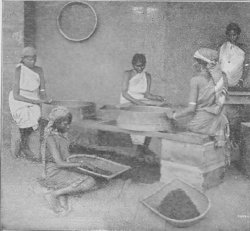 | 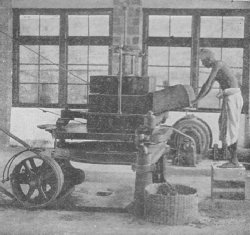 | | Getting dust out of tea. | Forcing moisture from the leaves. |
HOW TO PRESERVE NATURAL FLOWERS
CHEWING GUM AND ITS MANUFACTURE
Table of Contents
Return to Main Page
© 1998, 2002 by Lynn Waterman
|









